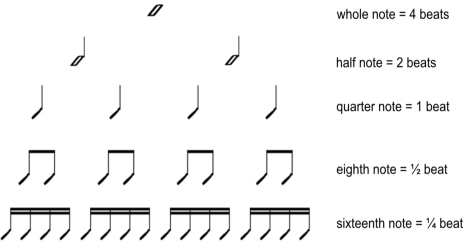
home \ tutorials \ reading rhythm page 4
Four in a beat
You can fit one quarter note in a beat.
You can fit two eighth notes in a beat.
You can fit four …… notes in a beat.
Got it? Right, four sixteenth notes!
The sixteenth note looks similar to an eighth note, with the difference that it has two flags.

You can write them as single notes, or group them the same way as eighth notes.



 =
=

Counting sixteenth can come in handy. However, counting them out loud may require some practice. You’ll need to find a way to quickly pronounce the four pulses per beat. Experiment a little. In the example below we use “uh”:

For better readability sixteenth and eighth notes can be grouped:
 =
=



Overview
Let’s add the sixteenth to the “note tree”:

The sound of silence: rests
In music, not playing is as important as playing. In music notation, not playing is written down as a “rest”. When you see a rest, it means silence. So If you strum a chord, and after that there is a rest, make sure your guitar is silent: stop your strings.
Rests come in the same values as notes: whole, half, eighth and sixteenth. And just as with notes, you can add a dot to extend there duration with half of their value.
Rest have their own symbols. Below is an overview. Take note of the difference between an whole and half rest (mnemonic: the whole rest is the lazy one, it hangs, the half rest stands firm).

Next we'll listen at some audio examples.
<<< Previous page | Next page >>>

Everything on guitartutorials.nl is completely free to access. If you’d like to support my work and help keep this resource growing, any and all donations are deeply appreciated. Thank you, and happy playing!